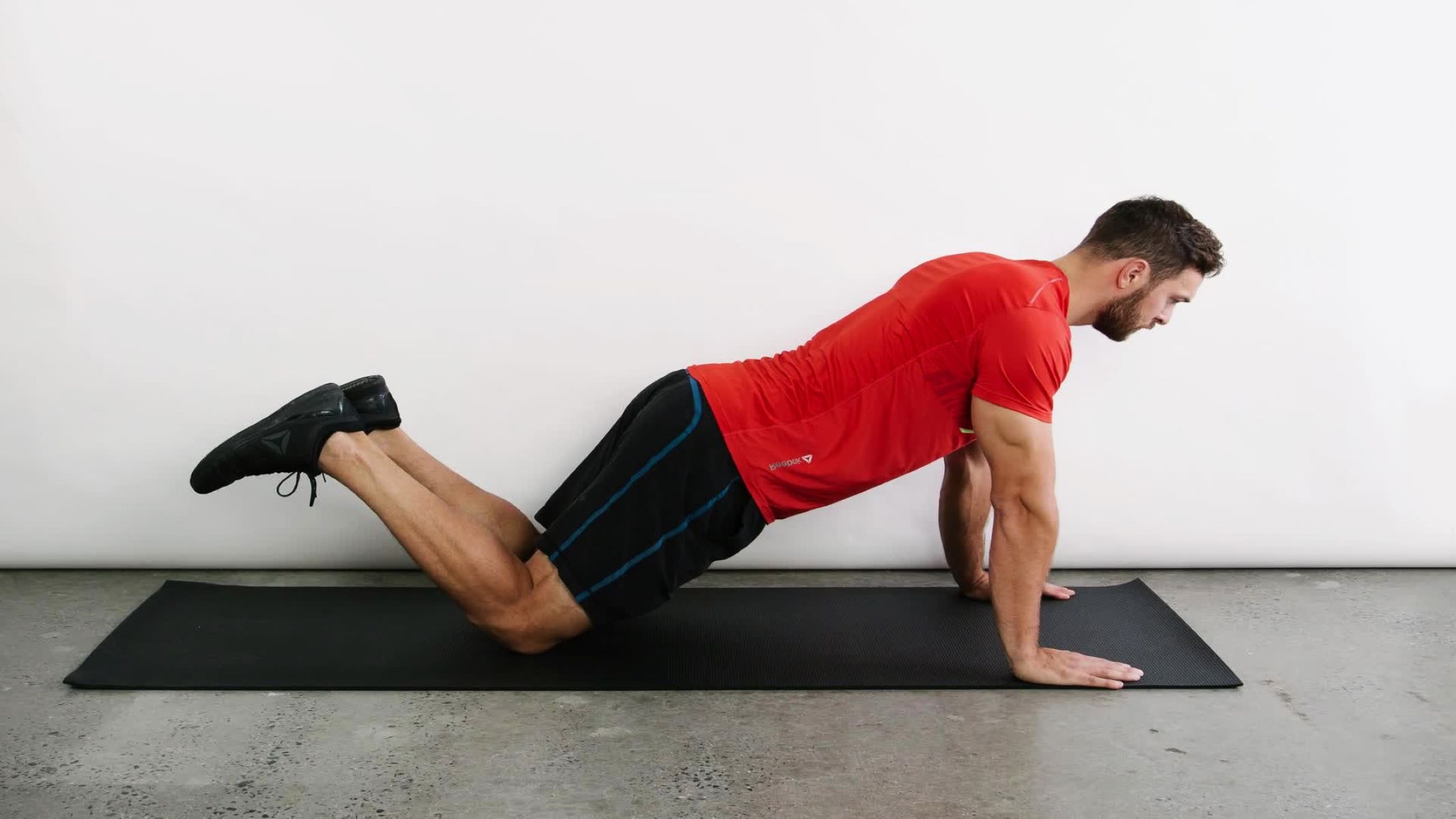Home>Training & Techniques>Mastering The Explosive Step-Up: The Key To Improving Your Running Performance


Training & Techniques
Mastering The Explosive Step-Up: The Key To Improving Your Running Performance
Published: March 2, 2024
Learn the best training and techniques for mastering the explosive step-up, a key to enhancing your running performance. Unlock your potential with expert guidance.
(Many of the links in this article redirect to a specific reviewed product. Your purchase of these products through affiliate links helps to generate commission for Therunningadvisor.com, at no extra cost. Learn more)
Table of Contents
- Understanding the Mechanics of the Explosive Step-Up
- Incorporating the Explosive Step-Up into Your Training Routine
- Common Mistakes to Avoid When Performing the Explosive Step-Up
- Tips for Maximizing the Benefits of the Explosive Step-Up
- Real-Life Examples of Athletes Who Have Improved Their Running Performance Through the Explosive Step-Up
Understanding the Mechanics of the Explosive Step-Up
The explosive step-up is a dynamic exercise that targets the lower body, particularly the quadriceps, hamstrings, glutes, and calves. It involves stepping onto an elevated platform using one leg and driving through the heel to propel the body upward. This movement not only builds strength but also enhances power and stability, making it a valuable addition to any runner's training regimen.
Key Muscles Engaged
During the explosive step-up, the quadriceps play a pivotal role in extending the knee as the body pushes upward. Simultaneously, the hamstrings and glutes are activated to stabilize the hip and control the movement. Additionally, the calf muscles are engaged to provide support and assist in the propulsion phase of the exercise. This coordinated effort among the major lower body muscle groups contributes to improved running performance by enhancing stride power and efficiency.
Proper Form and Technique
Executing the explosive step-up with proper form is essential for maximizing its benefits and minimizing the risk of injury. The movement begins with the foot firmly planted on the elevated platform, ensuring that the entire foot is in contact with the surface to provide stability. As the body ascends, the emphasis is placed on driving through the heel of the working leg, which activates the posterior chain and promotes optimal muscle recruitment. Maintaining a controlled descent back to the starting position is equally important, as it engages the muscles eccentrically, further enhancing strength and stability.
Benefits for Runners
For runners, mastering the mechanics of the explosive step-up translates to improved running performance in several ways. Firstly, the exercise strengthens the muscles involved in the propulsion phase of running, leading to more forceful and efficient strides. Additionally, the unilateral nature of the movement helps address muscle imbalances between the left and right legs, promoting symmetrical strength development and reducing the risk of injuries caused by asymmetries. Moreover, the explosive step-up enhances proprioception and balance, which are crucial for maintaining proper running form and preventing missteps during training or races.
Understanding the intricate mechanics of the explosive step-up empowers runners to leverage this exercise effectively in their training routines, ultimately leading to enhanced lower body strength, power, and stability. By incorporating this dynamic movement into their workouts, runners can take significant strides toward achieving their performance goals and staying injury-free.
Incorporating the Explosive Step-Up into Your Training Routine
Incorporating the explosive step-up into your training routine can yield substantial benefits for runners seeking to enhance their performance. This dynamic exercise not only targets key lower body muscles but also improves strength, power, and stability, all of which are essential for running efficiency and injury prevention. To effectively integrate the explosive step-up into your training regimen, consider the following guidelines:
Gradual Progression
When introducing the explosive step-up into your routine, it's crucial to start with a platform height that allows for proper form and control. Begin with a lower platform height and gradually increase the elevation as your strength and proficiency improve. This progressive approach minimizes the risk of injury and ensures that you can perform the exercise with optimal technique.
Repetitions and Sets
To derive maximum benefit from the explosive step-up, aim for a moderate number of repetitions and sets. Start with 2-3 sets of 8-12 repetitions per leg, focusing on maintaining proper form and control throughout each set. As your strength and endurance progress, you can adjust the sets and repetitions to align with your fitness goals and training intensity.
Integration with Plyometric Training
Incorporating the explosive step-up into a comprehensive plyometric training program can amplify its impact on running performance. Plyometric exercises, characterized by rapid and explosive movements, complement the explosive step-up by further enhancing lower body power and reactive strength. Consider integrating the explosive step-up with other plyometric exercises such as box jumps, bounding, and depth jumps to create a well-rounded training routine.
Periodization and Recovery
Incorporating the explosive step-up into your training routine should be part of a well-structured periodization plan. Periodization involves varying the intensity and volume of training over specific periods to optimize performance and allow for adequate recovery. Integrate the explosive step-up into different phases of your training plan, ensuring that there are periods of lower intensity to facilitate recovery and adaptation.
Progressive Overload
To continue reaping the benefits of the explosive step-up, it's essential to apply the principle of progressive overload. This involves gradually increasing the intensity, whether through elevated platform heights, added resistance, or advanced variations of the exercise. By progressively overloading the muscles, you stimulate ongoing strength gains and prevent plateauing in your training progress.
By incorporating the explosive step-up into your training routine with careful attention to progression, integration, recovery, and overload, you can harness the full potential of this exercise to elevate your running performance. With consistency and dedication, the explosive step-up can become a cornerstone of your training regimen, contributing to enhanced lower body strength, power, and stability for improved running efficiency and resilience.
Common Mistakes to Avoid When Performing the Explosive Step-Up
Performing the explosive step-up with improper form or technique can not only diminish its effectiveness but also increase the risk of injury. To maximize the benefits of this exercise and ensure safety, it's crucial to be mindful of common mistakes that individuals may encounter when incorporating the explosive step-up into their training routine.
Insufficient Platform Stability
Using an unstable or wobbly platform compromises the integrity of the exercise, leading to decreased effectiveness and potential injury. It's essential to select a sturdy and secure platform that provides a stable surface for performing the explosive step-up. This ensures that the focus remains on engaging the targeted muscles and executing the movement with proper form, without the distraction of platform instability.
Inadequate Range of Motion
Failing to achieve the full range of motion during the explosive step-up limits the activation of key muscles and diminishes the exercise's impact. It's important to ensure that the working leg fully extends at the top of the movement, with the hip and knee fully straightened. Additionally, lowering the body until the non-working foot gently touches the ground allows for optimal muscle engagement and ensures that the exercise is performed with the intended intensity.
Lack of Control and Balance
Rushing through the explosive step-up without adequate control and balance increases the risk of injury and reduces the exercise's effectiveness. It's essential to maintain control throughout the movement, emphasizing a slow and controlled descent from the elevated position. Additionally, focusing on balance and stability during each repetition enhances muscle engagement and promotes proper form, contributing to the exercise's overall efficacy.
Incorrect Foot Placement
Placing the foot incorrectly on the platform can compromise the exercise's biomechanics and lead to suboptimal muscle activation. It's important to position the entire foot firmly on the platform, ensuring that the heel is not hanging off the edge. This allows for proper distribution of weight and optimal engagement of the lower body muscles, maximizing the benefits of the explosive step-up.
Neglecting Symmetrical Execution
Failing to address muscle imbalances by neglecting symmetrical execution of the explosive step-up can perpetuate strength disparities between the left and right legs. It's crucial to perform an equal number of repetitions on each leg, ensuring that both sides receive balanced training stimulus. This approach promotes symmetrical lower body development, reduces the risk of injury, and contributes to improved running performance.
By being mindful of these common mistakes and prioritizing proper form, stability, range of motion, control, balance, foot placement, and symmetrical execution, individuals can optimize the effectiveness of the explosive step-up while minimizing the risk of injury. Awareness of these potential pitfalls empowers individuals to perform the exercise with precision, ultimately maximizing its benefits for lower body strength, power, and stability.
Tips for Maximizing the Benefits of the Explosive Step-Up
-
Focus on Proper Form: Emphasize proper form and technique to ensure that the targeted muscles are effectively engaged. This includes maintaining a stable platform, achieving full range of motion, and executing the movement with control and balance.
-
Progressive Overload: Gradually increase the intensity of the explosive step-up by incorporating higher platform heights, added resistance, or advanced variations. This progressive overload stimulates ongoing strength gains and prevents stagnation in training progress.
-
Integrate Plyometric Training: Combine the explosive step-up with other plyometric exercises to create a comprehensive lower body training regimen. Plyometric exercises enhance explosive power and reactive strength, complementing the benefits of the explosive step-up.
-
Mind-Muscle Connection: Focus on establishing a strong mind-muscle connection during the exercise. Concentrate on the targeted muscles, particularly the quadriceps, hamstrings, glutes, and calves, to maximize their activation and engagement.
-
Balanced Execution: Ensure symmetrical execution by performing an equal number of repetitions on each leg. Addressing muscle imbalances contributes to overall lower body strength and stability, reducing the risk of injuries associated with strength differentials between the legs.
-
Controlled Eccentric Phase: Place emphasis on the controlled descent from the elevated position during the explosive step-up. The eccentric phase of the movement, when the body lowers back to the starting position, is crucial for muscle development and stability.
-
Mindful Breathing: Pay attention to your breathing pattern during the exercise. Inhale as you lower your body and exhale as you push through the heel to ascend. Maintaining a consistent breathing rhythm enhances focus and supports optimal performance.
-
Recovery and Rest: Allow for adequate recovery between training sessions that incorporate the explosive step-up. Proper rest and recovery are essential for muscle adaptation and growth, ultimately maximizing the benefits derived from the exercise.
By implementing these tips, individuals can optimize the effectiveness of the explosive step-up, leading to enhanced lower body strength, power, and stability. Incorporating these strategies into training routines empowers individuals to leverage the full potential of the explosive step-up, ultimately contributing to improved running performance and overall athletic prowess.
Real-Life Examples of Athletes Who Have Improved Their Running Performance Through the Explosive Step-Up
Athletes across various disciplines have integrated the explosive step-up into their training routines, witnessing remarkable improvements in their running performance. One such example is Sarah, a dedicated long-distance runner who struggled with recurring knee pain and lacked the explosive power needed for strong finishes in races. Upon incorporating the explosive step-up into her strength training regimen, Sarah experienced a transformative shift in her running performance. The targeted engagement of her quadriceps, hamstrings, and glutes through the explosive step-up not only alleviated her knee discomfort but also enhanced her ability to generate powerful strides during races. As a result, Sarah achieved faster race times and felt more resilient during grueling training sessions, attributing much of her progress to the incorporation of this dynamic exercise.
Similarly, James, a competitive sprinter, sought to elevate his performance in short-distance races. Despite rigorous speed training, he found that his explosive acceleration off the starting line was lacking. Introducing the explosive step-up into his training routine proved to be a game-changer. The exercise's emphasis on explosive power and single-leg strength significantly enhanced James' ability to propel himself forward with greater force and speed. This newfound explosiveness translated into faster starts and improved overall race times, positioning James as a formidable contender in sprinting events.
Furthermore, elite marathon runner, David, faced the challenge of maintaining consistent pace and form during the latter stages of long-distance races. Fatigue often led to a decline in his running efficiency and compromised his finishing kicks. By integrating the explosive step-up into his training regimen, David honed his lower body strength and power, enabling him to sustain his pace and form through the demanding final miles of marathons. The enhanced muscular endurance and explosive capabilities derived from the exercise empowered David to finish races with renewed vigor, ultimately contributing to improved race performances and a heightened competitive edge.
These real-life examples underscore the profound impact of the explosive step-up on athletes' running performance. By addressing specific weaknesses, enhancing explosive power, and fortifying lower body strength, individuals like Sarah, James, and David have leveraged the benefits of this exercise to elevate their athletic prowess and achieve notable improvements in their respective running disciplines. Their experiences serve as compelling testaments to the transformative potential of the explosive step-up in enhancing running performance and propelling athletes toward their performance goals.












